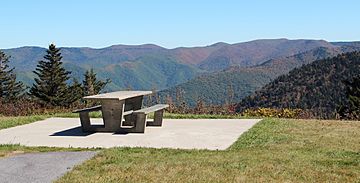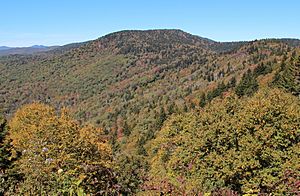Great Balsam Mountains facts for kids
Quick facts for kids Great Balsam Mountains |
|
|---|---|

Great Balsam Mountains as seen from the Blue Ridge Parkway
|
|
| Highest point | |
| Peak | Richland Balsam |
| Elevation | 6,410 ft (1,950 m) |
| Dimensions | |
| Length | 21 mi (34 km) |
| Width | 18 mi (29 km) |
| Geography | |
| Country | United States |
| State | North Carolina |
| Parent range | Appalachian Mountains |
| Geology | |
| Type of rock | gneiss |
The Great Balsam Mountains, also called the Balsam Mountains, are a cool mountain range in western North Carolina, United States. These mountains are part of the larger Blue Ridge Mountains, which are themselves a section of the huge Appalachian Mountains. One of the most famous peaks here is Cold Mountain. It's well-known because it's the main setting for the popular book Cold Mountain by author Charles Frazier.
The Blue Ridge Parkway, a famous scenic road, winds its way through the Great Balsam Mountains. At a spot called Richland Balsam (milepost 431), the Parkway reaches its highest point, soaring up to 6,053 feet!
Contents
Exploring the Peaks
The Great Balsam Mountains are home to many tall peaks, which are the highest points of the mountains. Here are some of the most important ones, listed with their heights:
- Richland Balsam – 6,410 feet (This is the highest peak in the range!)
- Black Balsam Knob – 6,214 feet
- Mount Hardy – 6,120 feet
- Reinhart Knob – 6,080 feet
- Grassy Cove Top – 6,040 feet
- Tennent Mountain – 6,040 feet
- Sam Knob – 6,040 feet
- Cold Mountain – 6,030 feet
- Shining Rock – 6,040 feet
- Chestnut Bald
Other Cool Places to See
Besides the mountain peaks, there are other interesting spots in the Great Balsam Mountains:
- Balsam Gap: This is a low point or pass between two mountains.
- Devil's Courthouse: A rocky peak with a unique shape.
- Judaculla Rock: An ancient rock with mysterious carvings. It's connected to local legends.
- Tanasee Bald: Another mountain peak with a special history.
Amazing Plants and Trees
The forests in the Great Balsam Mountains are a mix of different types of trees and plants. It's like a special meeting point between the cool, northern-style forests and the warmer, mixed forests found in other parts of America.
Trees of the High Mountains
At higher elevations, you'll find specific types of trees that love the cooler weather:
- Fraser fir: These trees are often called "balsams" or "She balsams." From far away, their forests look very dark. Sadly, these trees are facing a challenge from a tiny bug called the balsam woolly adelgid. This bug is causing many Fraser firs to decline.
- Red spruce: These are sometimes called "He balsams." You can tell them apart from Fraser firs because their bark doesn't have the same sticky sap, and their cones hang down.
Beautiful Shrubs
The mountains are also home to many colorful shrubs:
- Catawba rhododendron: These shrubs have beautiful purple flowers.
- Flame azalea: As their name suggests, these plants burst with bright orange and yellow flowers.
- Mountain laurel: This shrub has pretty white or pink cup-shaped flowers.
-
Rhododendron flowers in bloom.
-
Bright Flame azalea flowers.
-
Delicate Mountain laurel blossoms.





